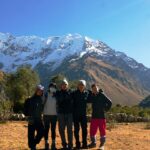2026 Best Salkantay Trek Companies in Peru

Sometime you read about the Inca Trail as the “must-do” to reach Machu Picchu, and yes, it’s historic and iconic. But for many of us, its popularity means crowds, fixed permits and rigid timing. The Salkantay Trek becomes an appealing alternative: no special permits, more flexibility, fewer people and a route that spans glaciers, high-mountain passes, cloud forest and jungle before arriving at the same destination.
If you’re considering Salkantay, this blog helps you see which version (3, 4, or 5 days) fits your time, energy and travel style. Plus, a guide to which companies are best to get you there.
3- vs 4- vs 5-Day Salkantay: What changes
| Option | Duration / Pace | Who it suits / Pros & Cons |
| 3-Day | Short, intense, compact experience | Good for travelers with limited time. Hits the highlights quickly. More demanding per day. |
| 4-Day | Balanced: intense but manageable, condensed over 4 days | Offers a full trekking arc (mountain → jungle → Machu Picchu) more quickly than 5-day, ideal if you have limited time but still want depth. 4-day has longer hikes per day and less rest. |
| 5-Day (Classic) | Gradual, relaxed pace — more time to adjust and enjoy | Best if you want a more complete, comfortable journey: altitude acclimatization, smoother transitions, slower pace, more time to appreciate scenery and culture. |
What stays the same: all versions cross the high point at the Salkantay Pass (4650 m), traverse changing ecosystems (mountains → cloud forest → jungle) and end at Machu Picchu.
Key difference: the pace, rest time, and how much “margin” you give yourself for altitude, acclimatization and recovery.
Recommended Operators for Salkantay
Here are three trusted companies and why I consider them top picks for The Salkantay Trek:
Sam Travel Peru
Because they focus on personalized, solid service. Good for travelers wanting a bit more comfort or flexibility. Their local knowledge and experience help especially if you’re new to Andean treks. Their familiarity with routes and logistics adds peace of mind.
69 Explorer
A locally-owned, experienced operator working in the “budget-tourism” segment. Great if you want a balance: reliable service, good guides and fair price without compromising core trekking quality. They specialize in treks around Cusco and have built a reputation for consistency. Only company offering the 3 days version.
Orange Nation Peru
They aim for detailed, slightly more “complete” Salkantay experiences, often including extras like visits to remote parts of the trail, quality camps or lodges, good meals and extra time for cultural immersion. Good option if you want more than just the “bare minimum” hike.
How These Operators Compare
| Company | Strengths / What stands out |
| Sam Travel Peru | Flexible options, attentive service, helpful for those new to trekking |
| 69 Explorer | Great balance of price + reliability + local expertise; trusted among budget and mid-range trekkers |
| Orange Nation Peru | More comfort, extra touches (good meals, well-organized camps/lodges, cultural value) |
Best Time for the Salkantay Trek and Who It’s For
- When to go: The dry season (roughly May to September) gives the most stable weather, clearer skies and easier hiking conditions.
- Who it suits:
- Adventurers short on time but eager for a rich experience, 3 or 4-day.
- Travelers wanting a more balanced, immersive journey with time to adapt to altitude, 5-day is ideal.
- For those wanting fewer crowds, high-mountain, jungle contrast and a scenic hike, Salkantay over the Inca Trail.
Because the trail moves from 4,600 m down to jungle levels, the trek appeals to people who enjoy variety: mountain landscapes, high passes, cloud forest, jungle heat and historic ruins all in one route.
Final Thoughts
The Salkantay Trek isn’t “one size fits all.” Whether you’re in a hurry or on your own time, there’s an option that fits. The 3-day gives intensity, the 4-day balances speed and depth, and the 5-day offers space to breathe, adapt and appreciate the Andes properly.
Choosing the right company helps you make the most of whichever version you pick. For a smooth, well-organized and meaningful trek, Sam Travel Peru, 69 Explorer or Orange Nation Peru stand out.



